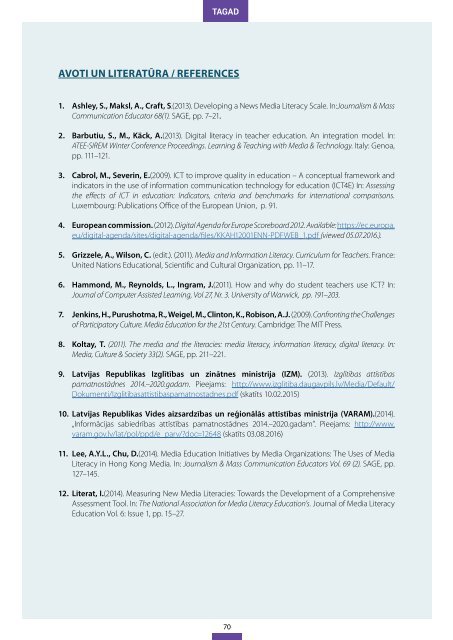TAGAD
Tagad_10_16
Tagad_10_16
Create successful ePaper yourself
Turn your PDF publications into a flip-book with our unique Google optimized e-Paper software.
<strong>TAGAD</strong><br />
AVOTI UN LITERATŪRA / REFERENCES<br />
1. Ashley, S., Maksl, A., Craft, S.(2013). Developing a News Media Literacy Scale. In:Journalism & Mass<br />
Communication Educator 68(1). SAGE, pp. 7–21.<br />
2. Barbutiu, S., M., Käck, A.(2013). Digital literacy in teacher education. An integration model. In:<br />
ATEE-SIREM Winter Conference Proceedings. Learning & Teaching with Media & Technology. Italy: Genoa,<br />
pp. 111–121.<br />
3. Cabrol, M., Severin, E.(2009). ICT to improve quality in education – A conceptual framework and<br />
indicators in the use of information communication technology for education (ICT4E) In: Assessing<br />
the effects of ICT in education: Indicators, criteria and benchmarks for international comparisons.<br />
Luxembourg: Publications Office of the European Union, p. 91.<br />
4. European commission. (2012). Digital Agenda for Europe Scoreboard 2012. Available: https://ec.europa.<br />
eu/digital-agenda/sites/digital-agenda/files/KKAH12001ENN-PDFWEB_1.pdf (viewed 05.07.2016.).<br />
5. Grizzele, A., Wilson, C. (edit.). (2011). Media and Information Literacy. Curriculum for Teachers. France:<br />
United Nations Educational, Scientific and Cultural Organization, pp. 11–17.<br />
6. Hammond, M., Reynolds, L., Ingram, J.(2011). How and why do student teachers use ICT? In:<br />
Journal of Computer Assisted Learning, Vol 27, Nr. 3. University of Warwick, pp. 191–203.<br />
7. Jenkins, H., Purushotma, R., Weigel, M., Clinton, K., Robison, A.J. (2009). Confronting the Challenges<br />
of Participatory Culture. Media Education for the 21st Century. Cambridge: The MIT Press.<br />
8. Koltay, T. (2011). The media and the literacies: media literacy, information literacy, digital literacy. In:<br />
Media, Culture & Society 33(2). SAGE, pp. 211–221.<br />
9. Latvijas Republikas Izglītības un zinātnes ministrija (IZM). (2013). Izglītības attīstības<br />
pamatnostādnes 2014.–2020.gadam. Pieejams: http://www.izglitiba.daugavpils.lv/Media/Default/<br />
Dokumenti/Izglitibasattistibaspamatnostadnes.pdf (skatīts 10.02.2015)<br />
10. Latvijas Republikas Vides aizsardzības un reģionālās attīstības ministrija (VARAM).(2014).<br />
„Informācijas sabiedrības attīstības pamatnostādnes 2014.–2020.gadam”. Pieejams: http://www.<br />
varam.gov.lv/lat/pol/ppd/e_parv/?doc=12648 (skatīts 03.08.2016)<br />
11. Lee, A.Y.L., Chu, D.(2014). Media Education Initiatives by Media Organizations: The Uses of Media<br />
Literacy in Hong Kong Media. In: Journalism & Mass Communication Educators Vol. 69 (2). SAGE, pp.<br />
127–145.<br />
12. Literat, I.(2014). Measuring New Media Literacies: Towards the Development of a Comprehensive<br />
Assessment Tool. In: The National Association for Media Literacy Education’s. Journal of Media Literacy<br />
Education Vol. 6: Issue 1, pp. 15–27.<br />
70


